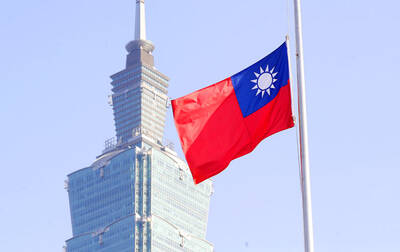The 98km2 of the Cappadocia region in Turkey make for a strange landscape. Powdery white soil gives the place a lunar feel. The hollowed out hillsides and 10m tall “fairy chimneys,” a tourist attraction crafted by wind and rain, could be leftovers from a 1970s James Bond set. At night, lights flicker in the cones of rock, which hundreds of people call home.
However, beneath the earth, things look even stranger: a network of caves, connected into what used to be entire subterranean cities. Derinkuyu, in southern Cappadocia, was once home to as many as 20,000 residents living together underground. There is a huge bathhouse, complete with a set of private rooms and tall ceilings to allow steam to rise, all of it ventilated by a system of shafts that run for dozens of kilometers in every direction — sometimes a vast distance from the populated areas to trick potential invaders.
Long abandoned, the underground cities of Cappadocia have rather suddenly been rediscovered: by the produce industry. The constant underground temperature of about 13°C make the caves an ideal storage climate for thousands of tonnes of fruit and vegetables: apples, cabbage and cauliflower stay fresh for up to four weeks; citrus fruits, pears and potatoes for months.
In a cave near the village of Ortahisar, nearly 6 million crates of lemons sit in endless stacks. They arrive from Turkey’s Mediterranean coast on trucks and are unloaded by hand. Workers — mostly women — package and stack the fruit, which are then stored underground until they are needed for export to Europe, Russia and elsewhere.
Araven Evi hotel operator Okan Yazgan has taken advantage.
“We have a cave store with a capacity of 100 tonnes, but we do not have a large enough area for growing potatoes. So we rent our store space,” he said.
The potatoes are stored underground and sold in situ when prices increase during winter and spring, Yazgan said.
The volcanic rock of these underground cities is moist and soft to the touch — a car key or pen easily leaves a mark — and the walls carry the marks of its former residents. Small ridges can be seen on the walls and ceilings, made as long as 3,500 years ago by the first people to realize that they could chisel out a home here. They liked living underground for much of the same reason that the produce vendors do: When visiting Cappadocia in 400 BC, Xenophon, a student of Socrates, reported seeing goats, sheep, cows and poultry fed on straw and hay.
“Corn, rice, vegetables and barley beer was stored in large pots,” he wrote.
Could other cities learn from Cappadocia’s example? Berlin is home to many kilometers of underground tunnels and rooms, built in World War II to protect against bombings; Switzerland has enough underground space to shelter every citizen in the event of nuclear war. Meanwhile, Singapore is planning to use a 60-hectare cavern under the city to store fuel and build a facility for scientists and researchers.
Although cities that do not already have underground space would likely see limited benefits — meat and frozen foods certainly would require the refrigeration only fridges and supermarkets freezers provide — Nikolai Bobylev, an environmental scientist at Saint Petersburg State University, says underground urban space is an overlooked resource.
“We can use underground space for all the urban services that do not require daylight — transport, waste management, retail,” he says. “Thus we can save pressure [on] above-ground space for living, recreation, greenery — creating compact and more sustainable cities.”
In Cappadocia, some of the underground warehouses have a capacity of 20,000 tonnes, but the financial incentive is proving irresistible: Local companies and those in the produce business have begun carving out new caves in the rock, and multinational firms such as Frito Lay are reported to be planning to invest.

When Lika Megreladze was a child, life in her native western Georgian region of Guria revolved around tea. Her mother worked for decades as a scientist at the Soviet Union’s Institute of Tea and Subtropical Crops in the village of Anaseuli, Georgia, perfecting cultivation methods for a Georgian tea industry that supplied the bulk of the vast communist state’s brews. “When I was a child, this was only my mum’s workplace. Only later I realized that it was something big,” she said. Now, the institute lies abandoned. Yellowed papers are strewn around its decaying corridors, and a statue of Soviet founder Vladimir Lenin

UNIFYING OPPOSITION: Numerous companies have registered complaints over the potential levies, bringing together rival automakers in voicing their reservations US President Donald Trump is readying plans for industry-specific tariffs to kick in alongside his country-by-country duties in two weeks, ramping up his push to reshape the US’ standing in the global trading system by penalizing purchases from abroad. Administration officials could release details of Trump’s planned 50 percent duty on copper in the days before they are set to take effect on Friday next week, a person familiar with the matter said. That is the same date Trump’s “reciprocal” levies on products from more than 100 nations are slated to begin. Trump on Tuesday said that he is likely to impose tariffs

HELPING HAND: Approving the sale of H20s could give China the edge it needs to capture market share and become the global standard, a US representative said The US President Donald Trump administration’s decision allowing Nvidia Corp to resume shipments of its H20 artificial intelligence (AI) chips to China risks bolstering Beijing’s military capabilities and expanding its capacity to compete with the US, the head of the US House Select Committee on Strategic Competition Between the United States and the Chinese Communist Party said. “The H20, which is a cost-effective and powerful AI inference chip, far surpasses China’s indigenous capability and would therefore provide a substantial increase to China’s AI development,” committee chairman John Moolenaar, a Michigan Republican, said on Friday in a letter to US Secretary of

ELECTRONICS BOOST: A predicted surge in exports would likely be driven by ICT products, exports of which have soared 84.7 percent from a year earlier, DBS said DBS Bank Ltd (星展銀行) yesterday raised its GDP growth forecast for Taiwan this year to 4 percent from 3 percent, citing robust demand for artificial intelligence (AI)-related exports and accelerated shipment activity, which are expected to offset potential headwinds from US tariffs. “Our GDP growth forecast for 2025 is revised up to 4 percent from 3 percent to reflect front-loaded exports and strong AI demand,” Singapore-based DBS senior economist Ma Tieying (馬鐵英) said in an online briefing. Taiwan’s second-quarter performance beat expectations, with GDP growth likely surpassing 5 percent, driven by a 34.1 percent year-on-year increase in exports, Ma said, citing government